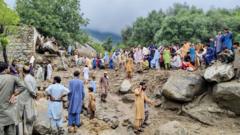At least 164 people have lost their lives in the last 24 hours due to severe monsoon floods and landslides affecting Pakistan and Pakistan-administered Kashmir. The majority of fatalities, totaling 150, have been reported from the mountainous region of Khyber Pakhtunkhwa in northern Pakistan. This area has experienced catastrophic flooding, with at least 30 homes damaged and the crash of a rescue helicopter during operations resulting in the deaths of its five crew members.
Additionally, there have been nine casualties in Pakistan-administered Kashmir and five in the northern region of Gilgit-Baltistan. Government weather experts are forecasting continued heavy rain until August 21, and several areas have already been designated as disaster zones. Ali Amin Gadapur, the chief minister of Khyber Pakhtunkhwa, attributed the helicopter crash to poor weather conditions as it was en route to Bajaur, a border area adjacent to Afghanistan.
In Bajaur, locals mourned their losses as large crowds gathered around excavating equipment, and funeral prayers were conducted nearby for victims found in the debris. In Indian-administered Kashmir, the impacts of the floods were also felt severely, with rescuers recovering bodies from the aftermath where at least 60 individuals were confirmed dead after a flood swept through a Himalayan village.
The monsoon season, which lasts from June to September, contributes about three-quarters of the annual rainfall for South Asia, making flooding and landslides recurrent threats. This year alone has seen over 300 fatalities related to weather incidents, with July exhibiting a worrying trend as Punjab—home to nearly half of Pakistan’s population—recorded 73% more rainfall compared to the previous year, leading to increased fatalities.
Experts attribute the growing severity and frequency of such weather events to the impacts of climate change, raising alarm about the future challenges that South Asia may face concerning severe weather patterns and disasters.




















